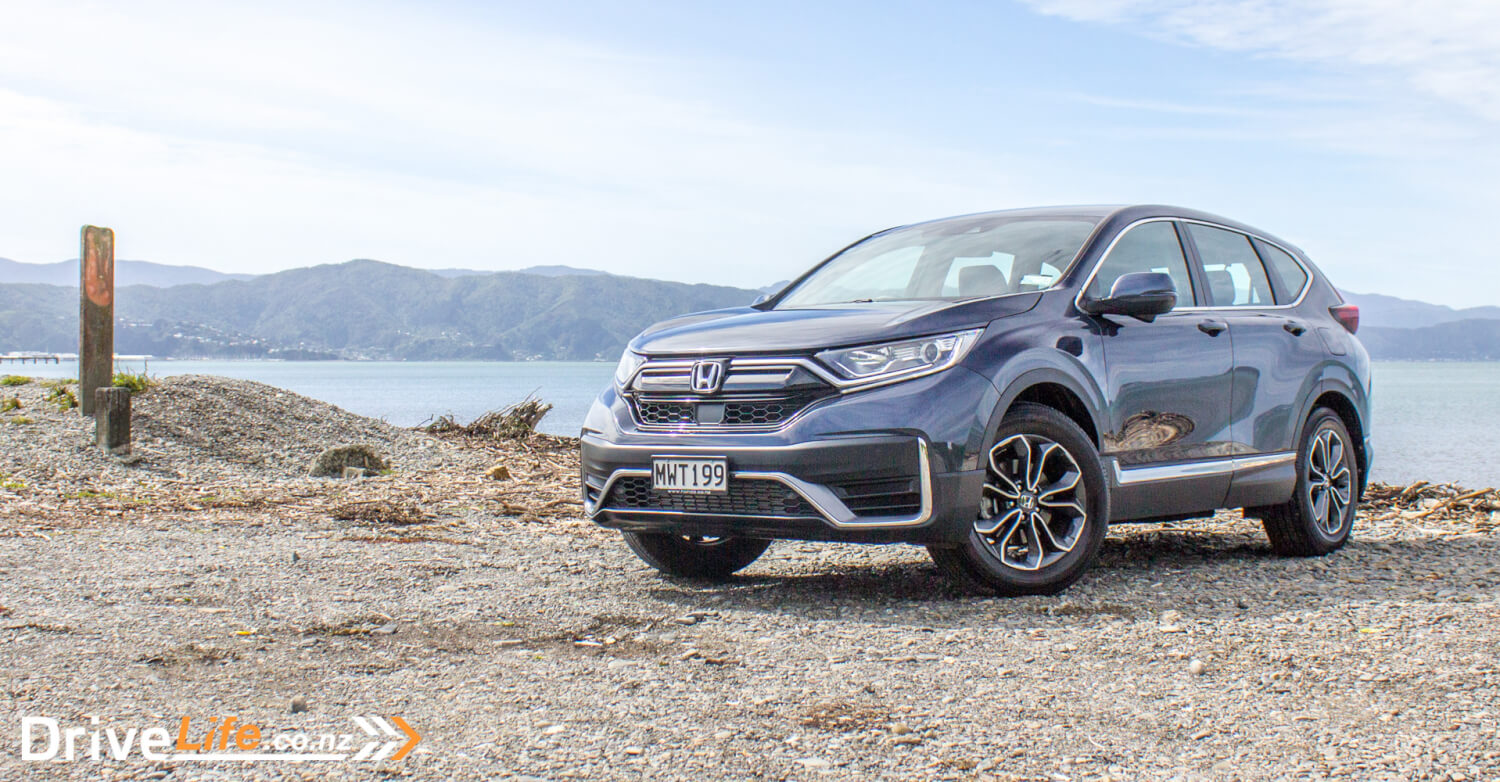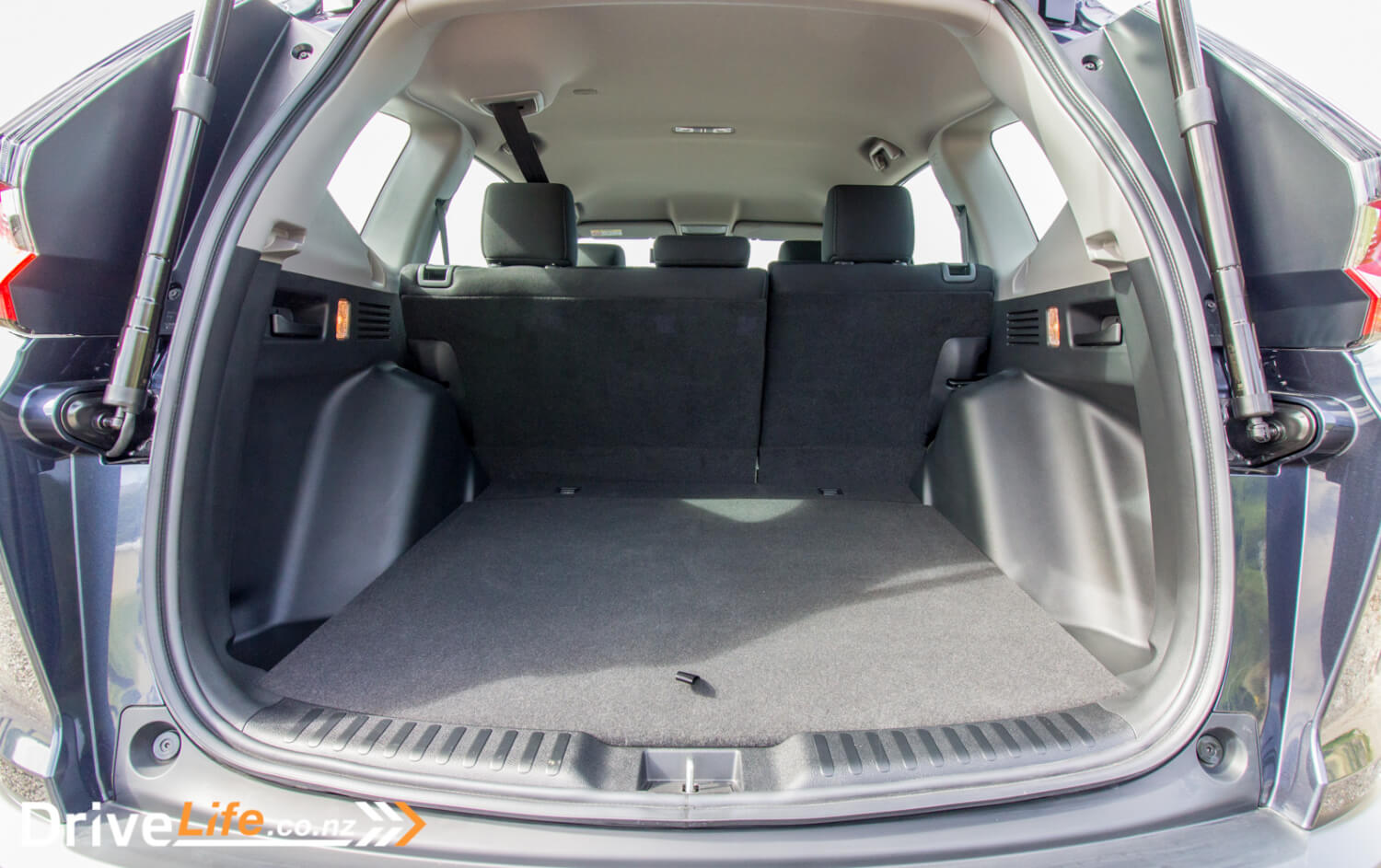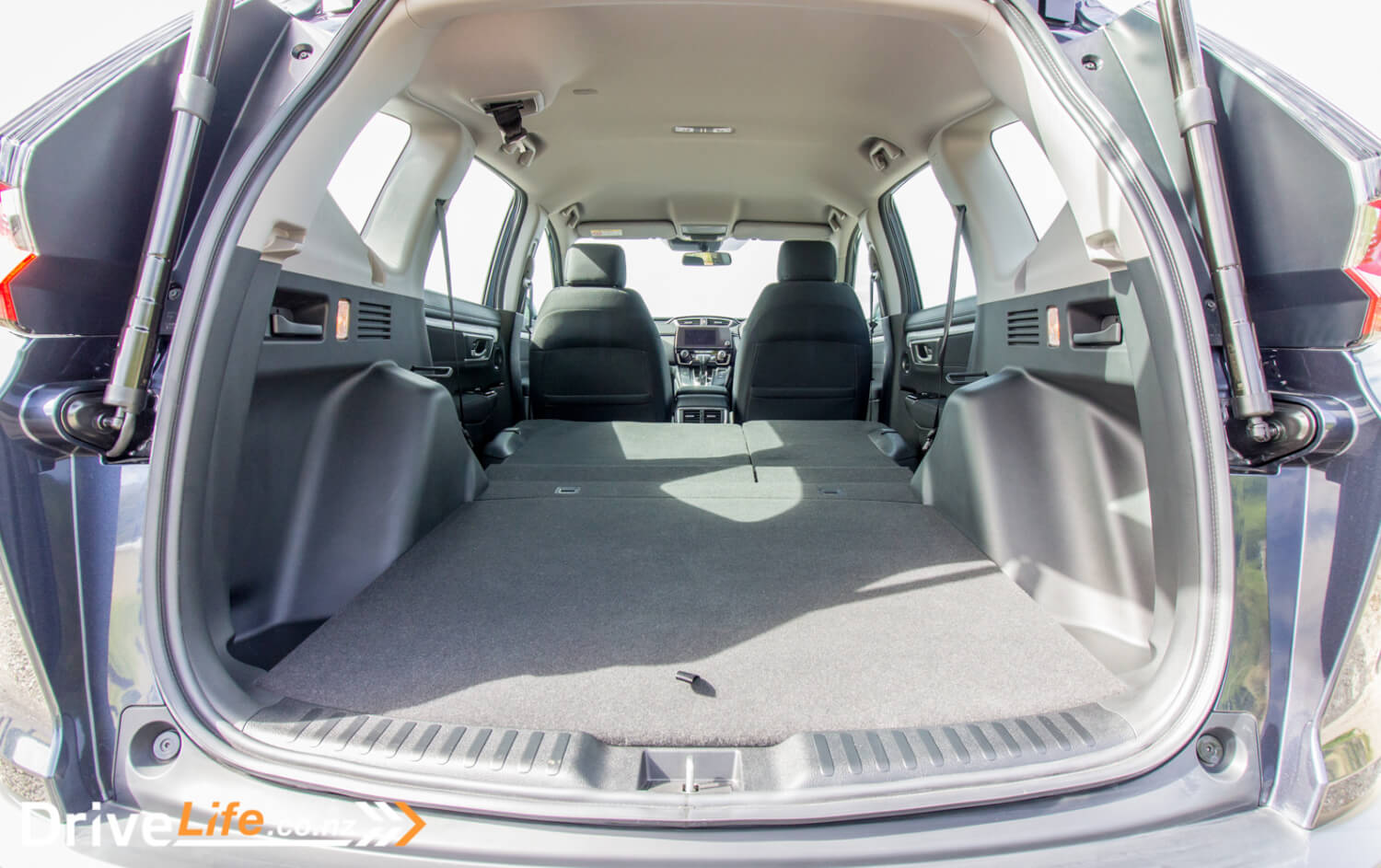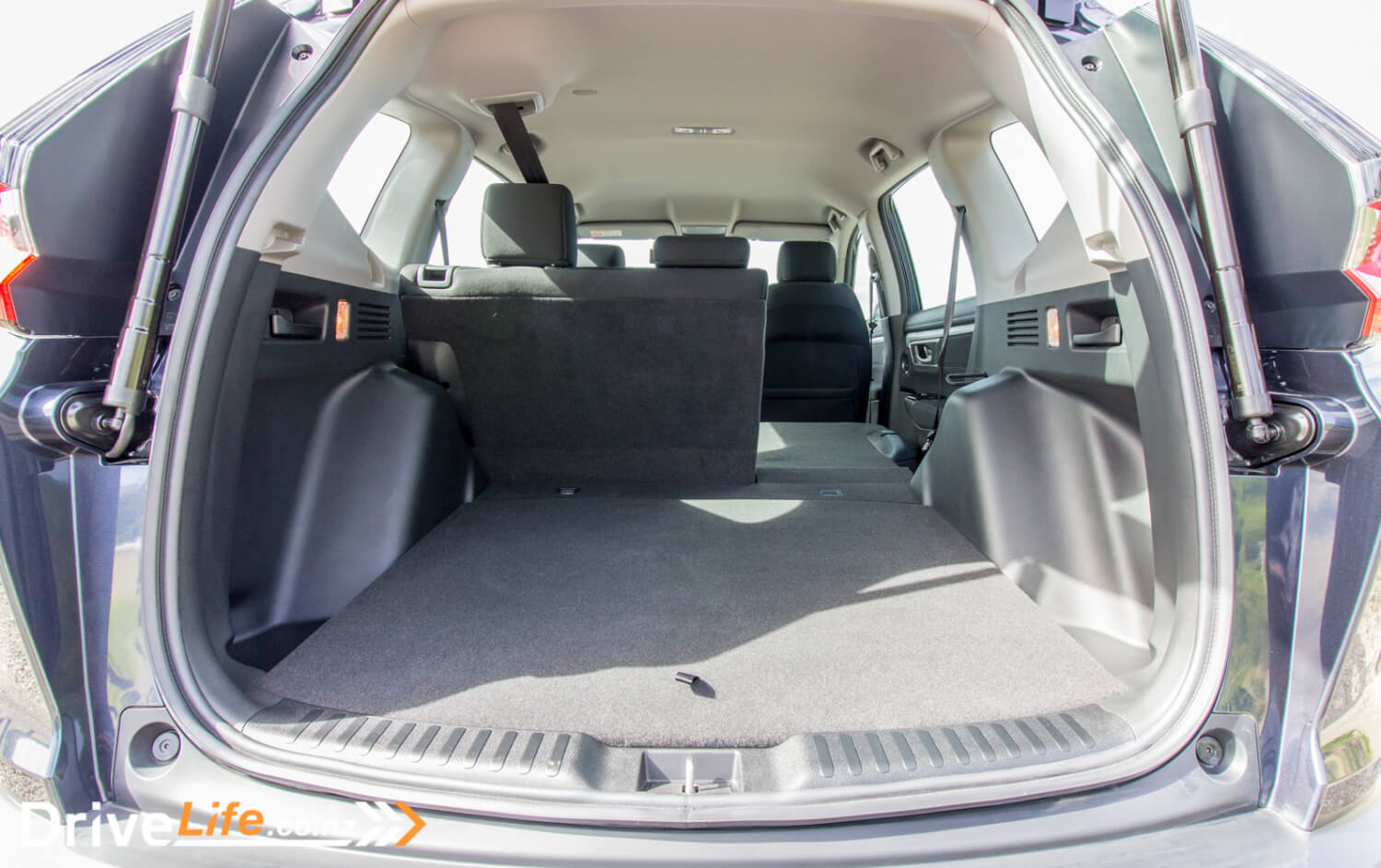It’s one of those cars you see everywhere, once you start looking for them. New Zealand may have a lot of medium SUVs for sale, but the Honda CR-V (Compact Recreational Vehicle) seems to do well, based on how many you might see driving around town or at the ski fields. In fact, according to Honda, it’s the third most popular crossover on our roads.
For 2020, Honda has added their Honda Sensing safety pack to all models, as well as an exterior redesign with new colours, and there’s some other goodies that have been added as standard.
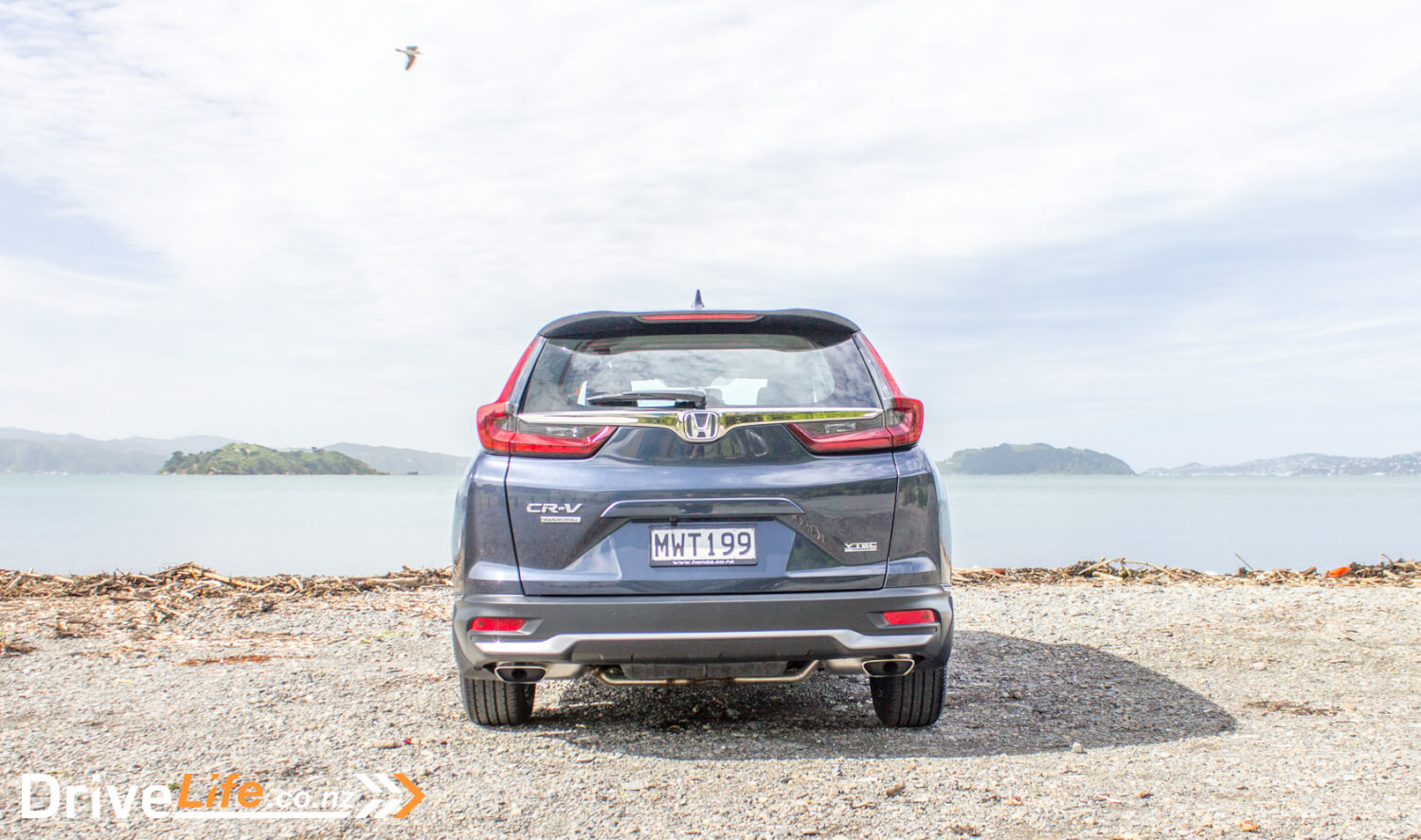
For this review, we’re starting off with the base front-wheel drive (FWD) Touring model for a week, then will spend a week with the top-spec all-wheel drive (AWD) Sport Premium model, to compare them.
We last drove this car in 2017, and there aren’t that many changes on the new model. Will those changes be enough to keep buyers loyal? We spend a week with each model to find out.
Note: Base model used in photographs
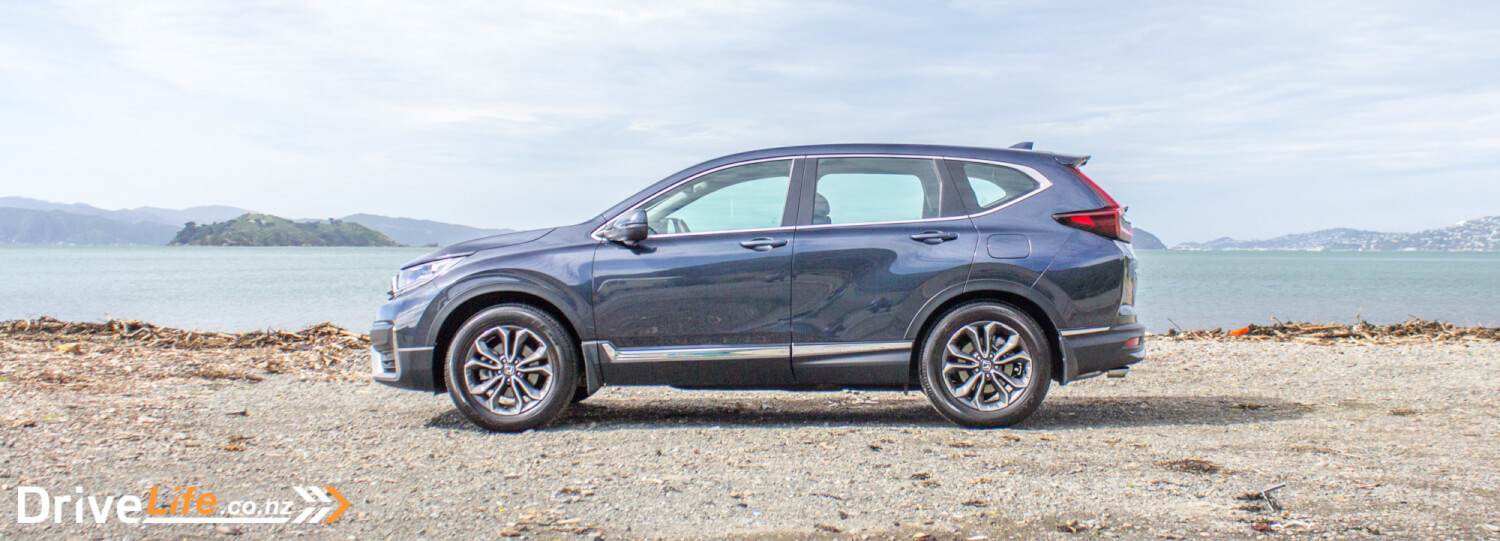
What’s in the 2020 Honda CR-V Range?
There’s 4 models in Honda’s CR-V range; Touring, Sport 7, AWD Touring, and AWD Sport Premium.
One engine powers all models, and there’s just one transmission, a Constantly Variable (CVT). The engine is a 1.5-litre, four-cylinder turbo-petrol unit, putting out 140kW of power and 240Nm of torque.

Standard equipment is where the CR-V shines. Even the base model has 18” alloy wheels with a full-size spare, halogen projector headlights, Intelligent Auto Headlights, LED Daytime Running Lights (DRL), front and rear parking sensors, hands-free power tailgate, keyless entry and start, leather steering wheel, Intelligent Dual Zone Digital Climate Control with Rear Ventilation, customisable speed alarm, 60:40 Folding Rear Seat with ISOFIX, 7” touch screen, Apple CarPlay and Android Auto, SatNav, USB Ports (front & 2nd row), Dynamic Parking Aid, Active Noise Cancellation, Lane Watch Camera, Driver Attention Monitor, Trailer Stability Assist, Agile Handling Assist, Motion Adaptive Electric Power Steering, Tyre Deflation Warning System, Emergency Stop Signal, Hill Start Assist, Adaptive Cruise Control, Low Speed Follow, Lane Keep Assist System, Collision Mitigation Braking System, Forward Collision Warning, Road Departure Mitigation, Lane Departure Warning, Auto High-beam Support System. That’s a fair list for a base model.
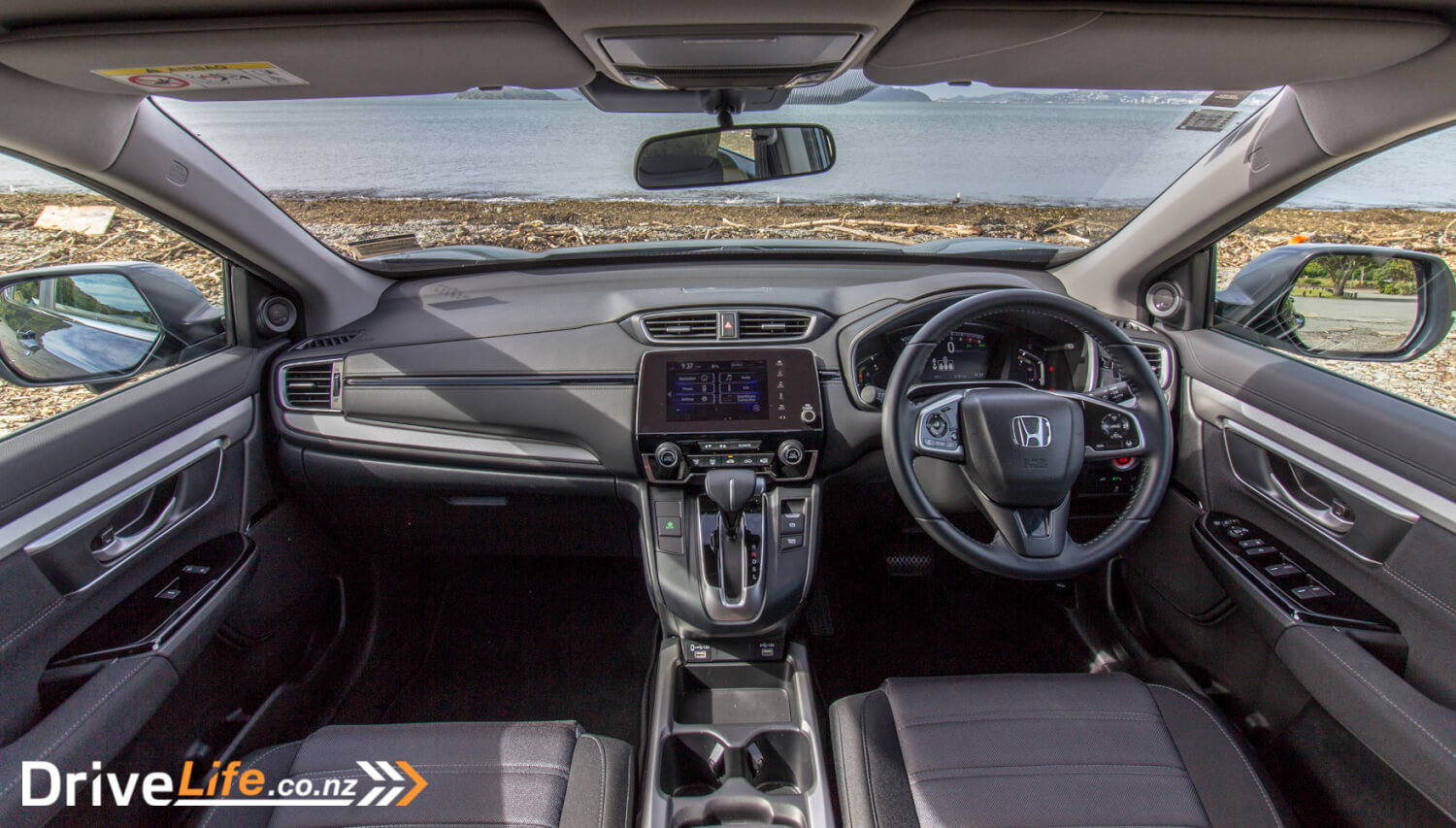
The Sport 7 model has seven seats of course, but also adds, 18” alloy wheels and still with a full size spare, panoramic Sky Roof (with tilt/slide functions), LED Intelligent auto headlights, LED front fog lamps, auto wipers, Active Cornering Lights, Roof Rails, and privacy glass (Rear), leather seats, heated front seats, 8-way electric driver’s seat with memory, Qi wireless charger, steering wheel mounted shift paddles, ambient interior lighting, climate control (including rear fan controls) and digital radio.
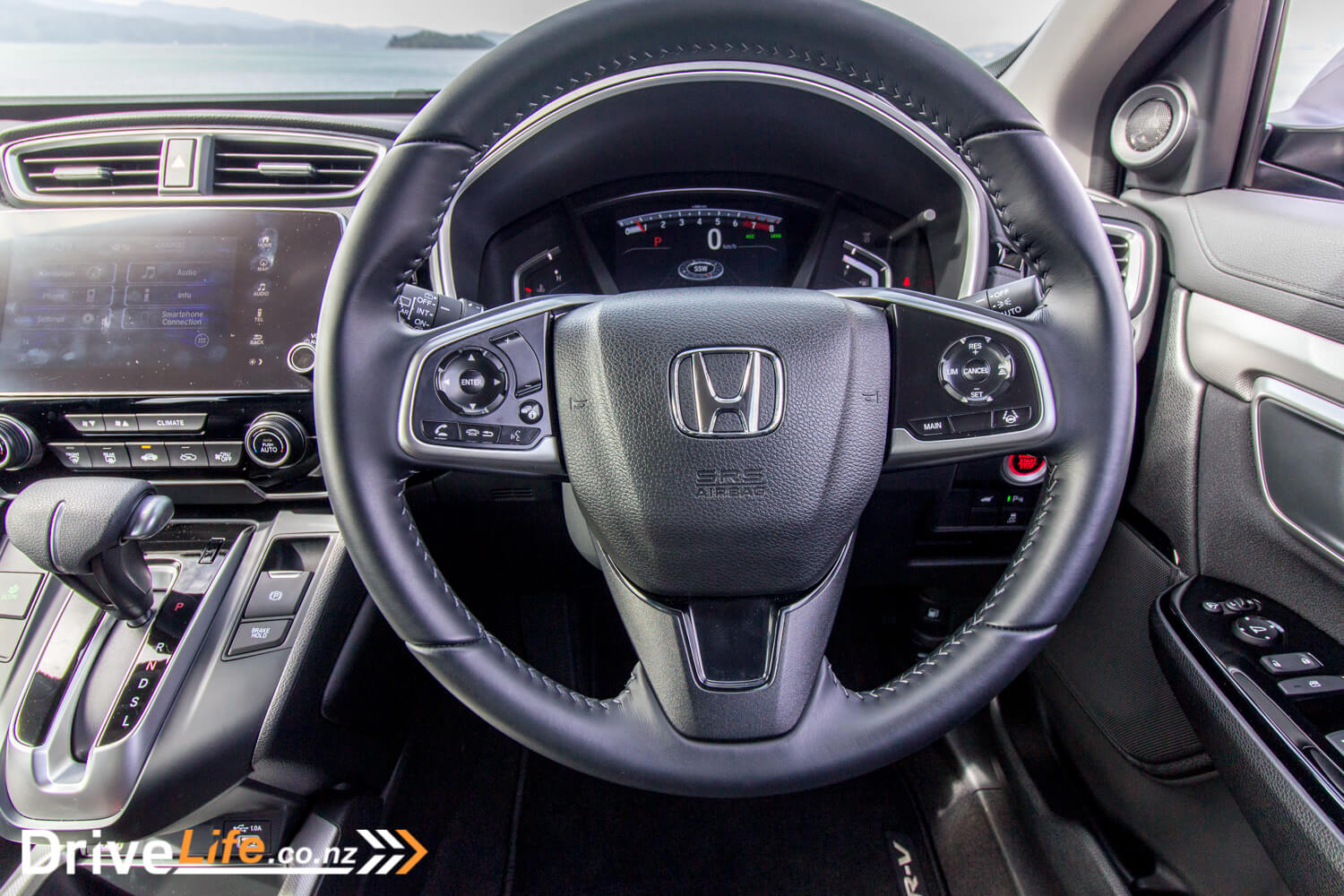
Moving to the top-spec Sport Premium, wheels move up to 19”, and there’s also auto wipers, hydrophilic & heated door mirrors with auto reverse tilt, all windows auto up/down, and a 4-way electric passenger’s seat.
Pricing:
- Touring $39,990
- Sport 7 $47,990
- AWD Touring $43,990
- AWD Sport Premium $51,790
You can read more about the Honda CR-V range on Honda New Zealand’s website.
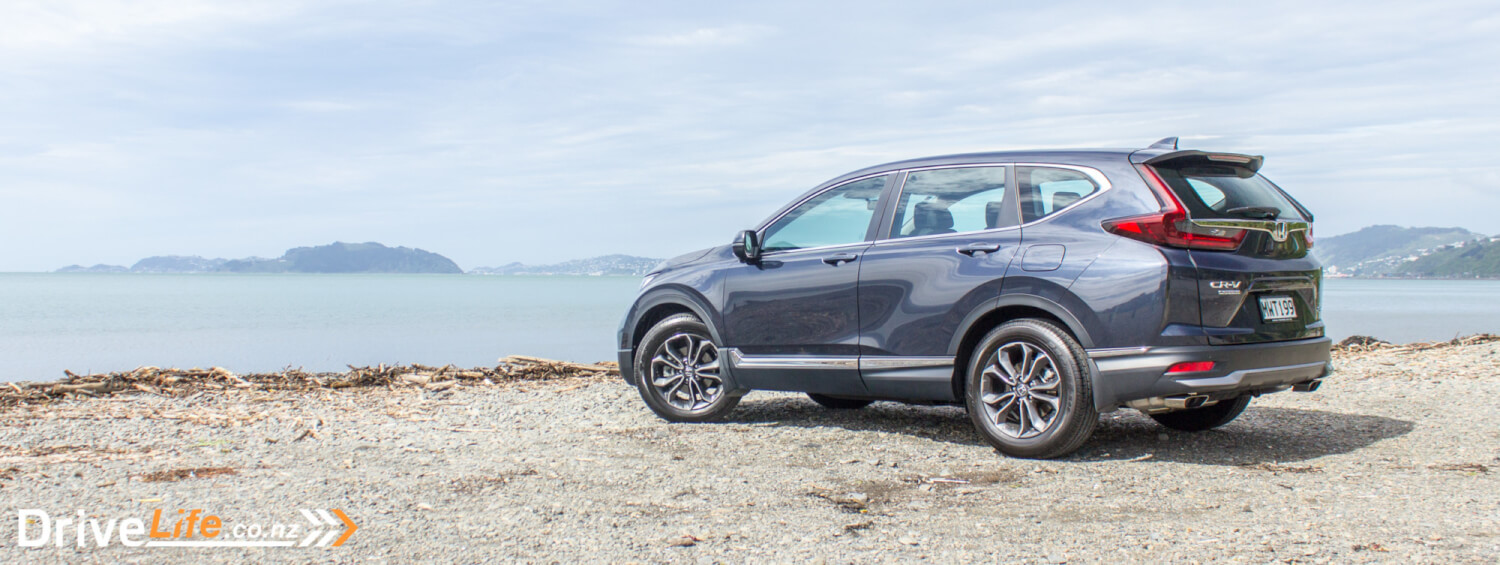
First Impressions Of The 2020 Honda CR-V
I’ve always found the front of the CR-V (and the HR-V for that matter) a little too busy; too many angles, lines and shapes. This hasn’t really changed for 2020, but it does seem to work; the 2020 Honda CR-V is a good-looking car.
It was interesting when I went to pick up the base model, I thought they had brought me the top-spec version. There’s lots of chrome trim where you wouldn’t expect to see any at all, the alloy wheels look great, and the whole look of the car screams out top-spec. But no, this was the base model.

When I picked up the top-spec Sport Premium model, there wasn’t a lot of difference. Sure, the alloy wheels are an inch bigger, but there’s little on the outside to differentiate them.
Some may consider the CR-V to be a large SUV, but it borders more on the midsize-SUV than a large one. We had a Mazda CX-9 parked outside the house one day, you can really see the difference in size:
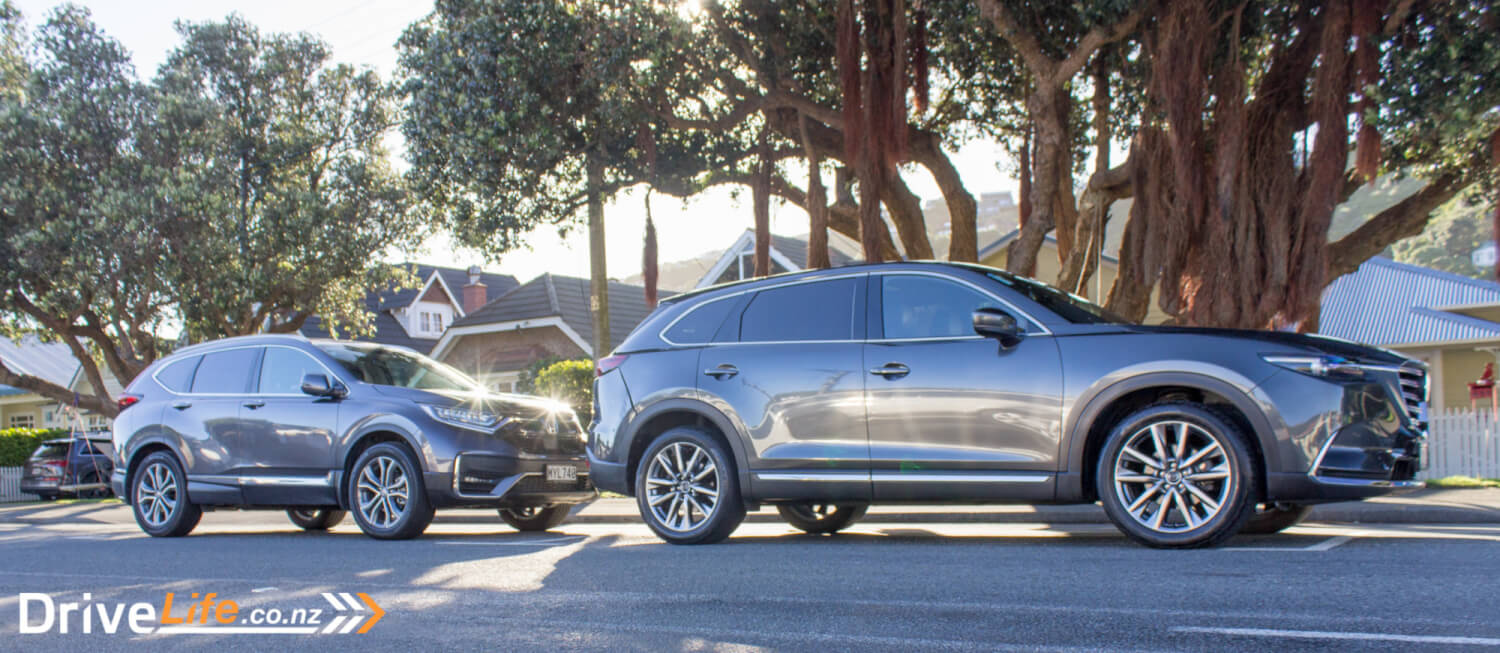
What’s The Interior On A 2020 Honda CR-V Like?
Repeating my experience with the look of the base model, I opened the tailgate – it’s electric? Again, this is the base model, and yet inside you’ll find an electric tailgate with foot operation, dual-zone AC, SatNav, automatic high-beams and also some excellent material usage splashed about the place. Even the base model only has three switch blanks, a sure sign of being well equipped.

For example, the doors do have black, hard-plastic lowers, but it’s a cloth-covered pad where your arm rests both on the door and on the arm rest. It looks and feels excellent, making you feel like you’ve spent more money than you have, and if I’m being honest, looks and feels better than the top-spec Sport Premium model.
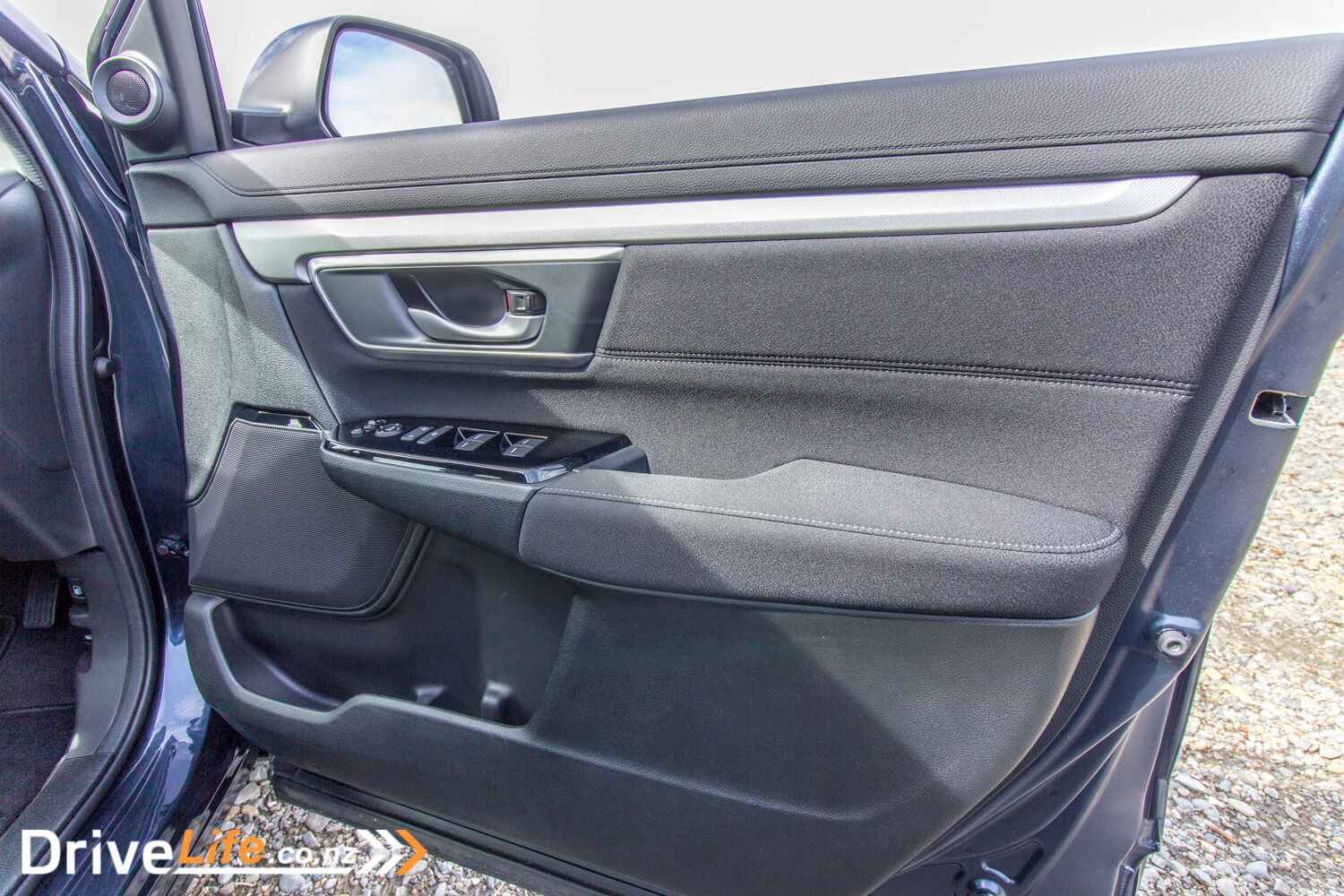
The interior has a beige headlining and pillars and feels nicely airy. In fact, the whole interior feels quite spacious and light, let down a little by some decidedly chunky C pillars.
From the driver’s seat, there’s a reasonably deep, square centre cubby that can easily take an SLR camera, with space to spare. The padded top of it is sliding too, something that’s always appreciated. In front of the cubby there’s a removable panel, and it’s a great spot to put your cellphone, or take the panel away completely for extra space underneath. Right up front there’s a Qi wireless charging pad for the top-spec, but not for the Touring model.
Up on the roof, Honda has placed a ‘conversation mirror’; a small plastic mirror that pops down and allows you to have eye contact with rear seat passengers. I know some parents that make good use of this when there are certain personality types in the back seat.

Stepping into the Premium model, the differences are pretty obvious. There’s leather seating, the Qi charger, a big electric panoramic sunroof with electric blind, and the front seats are heated and electric with two memory settings for the driver.
Headroom up front is excellent, even with the electric sunroof of the Sport Premium. Rear headroom in the Sport Premium is a little more, well, premium, but the base spec is excellent. While the CR-V doesn’t have Honda’s amazing Magic Seats, the front passenger’s seat does fold flat down, enabling full-length loads to be carried. The second row folds flat too, something that’s missing from a lot of SUVs.
Rear leg room also borders on excellent; I’m not a tall person by any means, but I can’t see your rear passengers complaining about that. Back there they have access to two 2.1-amp USB ports – which should charge a large tablet – as well as a couple of air vents in the centre console.

The boot is particularly spacious at 522 litres with the seats up. And lo and behold, there’s a full-size alloy spare wheel under the floor. Not sure the last time I saw one of those. I see that even the 7-seater has a full-size spare, which is impressive. Another bonus at the back of the car is the very low loading height. It’s right down there and should make getting your stuff in and out a lot easier. Loading height seemed to have crept up a lot with the latest, sexy design of SUVs, so it was awesome to see Honda throwing that concept out the window.
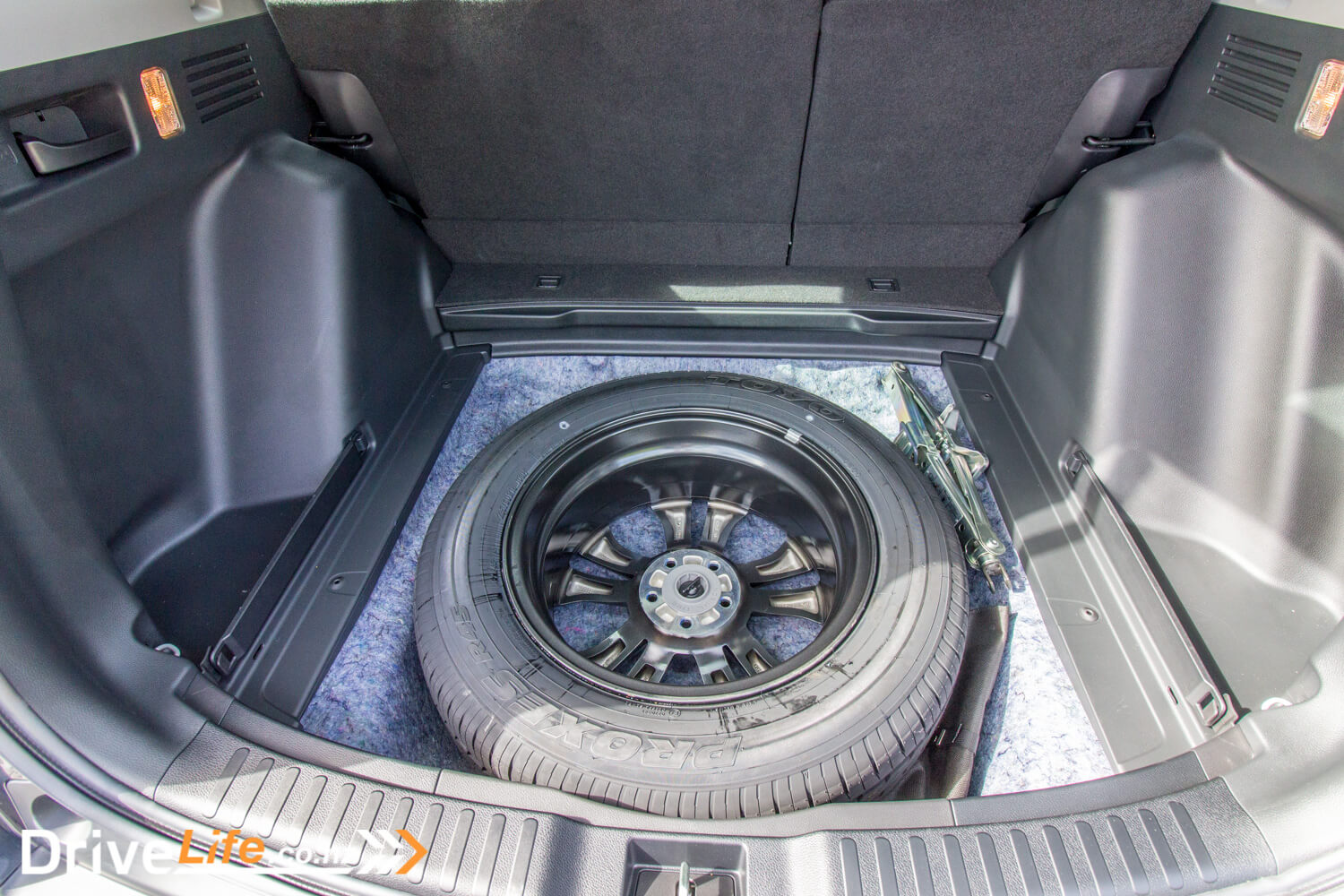
What’s It Like to Drive A 2020 Honda CR-V Touring?
I’ve never been a fan of Honda Constantly Variable Transmissions (CVT) but I have to admit, they have been improving this over the years. This was going to be the main thing I wasn’t looking forward to, but my first five minutes was enough to win me over; it’s very driveable. There isn’t too much CVT flaring, and just tootling around town the CVT does just fine. Up hills, it does ‘change down’ when you need it to or when you give it a bit more gas, so on the whole for your average driver, the CVT is spot on. Full-throttle acceleration will see CVT flaring, but it’s acceptable.
Both models have the same engine, a 1.5-litre, 4-cylinder turbo petrol unit, and this does well considering the size of the car. It’s quiet enough when not working hard, and this is evident on the motorway where there’s almost no engine noise at all at a steady throttle. It feels peppy enough around town, but I didn’t get a chance to load the car up with passengers, and I think this is where it might struggle. I give this engine a passing grade; it does the job and it’s smooth and quiet enough up to a point, but you do need a fair amount of accelerator pedal to move the car along. This isn’t really reflected in fuel consumption though; Over both cars and around 900Km of mixed driving, I averaged 7.7L/100km, which is pretty close to what Honda suggests, at 7.4L/100km.
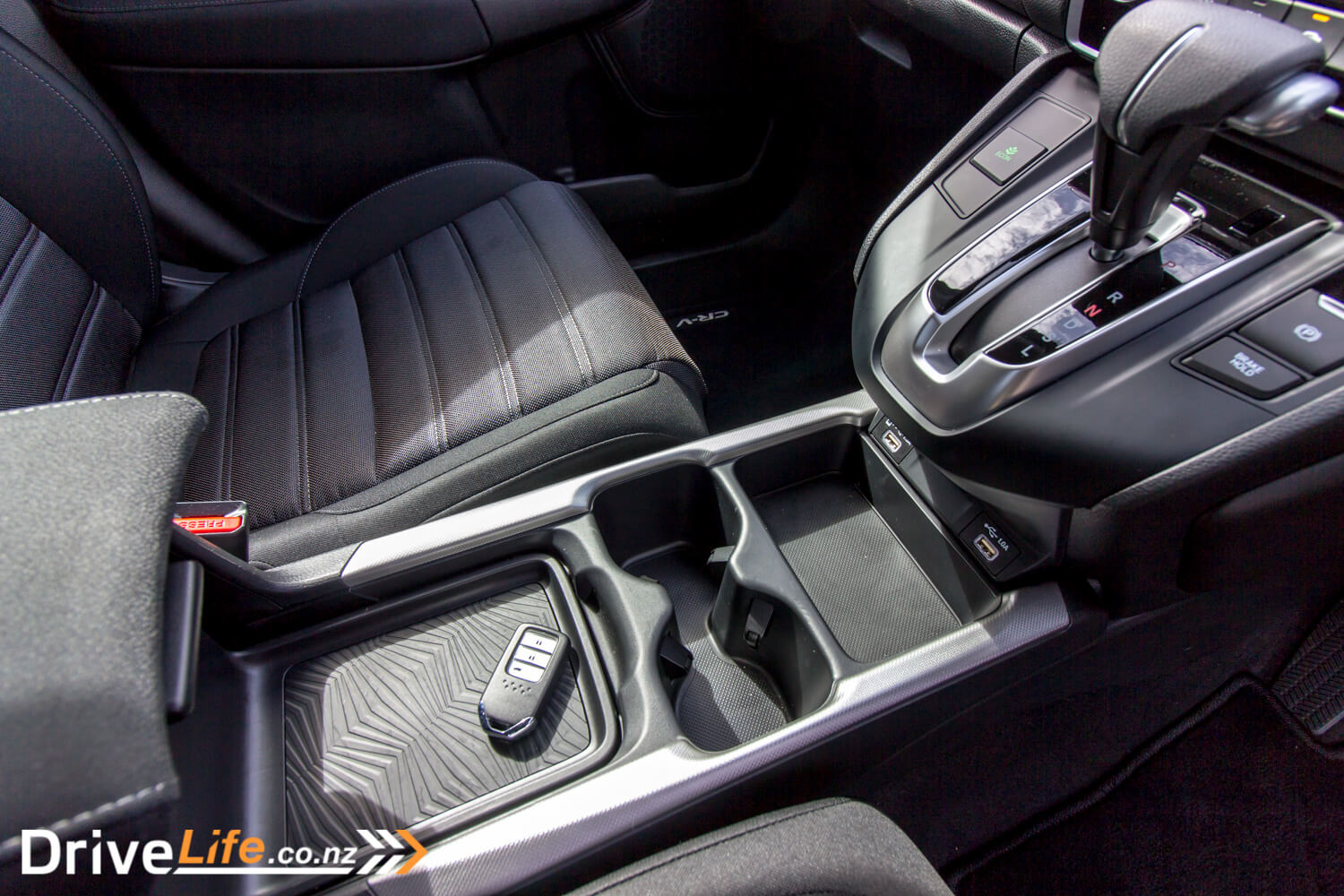
There’s no drive modes in the CR-V, other than an Eco button. I did use this a few times to test it out, but it pushed acceleration down to the too-slow area. On the motorway however, it’s quite usable if you have adaptive cruise control on. Flying in the face of what’s popular, there’s no engine auto-off function. I’m not saying the car needs it, but it’s a pretty standard feature these days.
Surpassing some much more expensive European cars, even the base Touring model CR-V is equipped with adaptive cruise control. This was excellent to see, especially after my recent experience with the $83,500 Audi A5 which doesn’t have adaptive cruise as standard. The CR-V’s cruise control works well for the most part, bringing the car to a stop in traffic. It was on a Saturday that we had to go to Kapiti, and the return trip – which normally takes less than an hour – took 2.5 hours. It was hell, and most of that time was spent covering 7Km at a crawling pace, stopping and starting. You know the drill. But this was where the adaptive cruise saved the day. While the CR-V’s adaptive cruise control won’t start off again automatically (very few cars will), just tapping the gas pedal lightly would get the car moving again. It took so much stress out of that crawling traffic jam, as I set cruise control for 30km/h, and let the car do the driving for me. I still had to steer, but it took away any chance of a nose-to-tail – at least where I would be at fault. I love adaptive cruise control, even just for traffic jams.
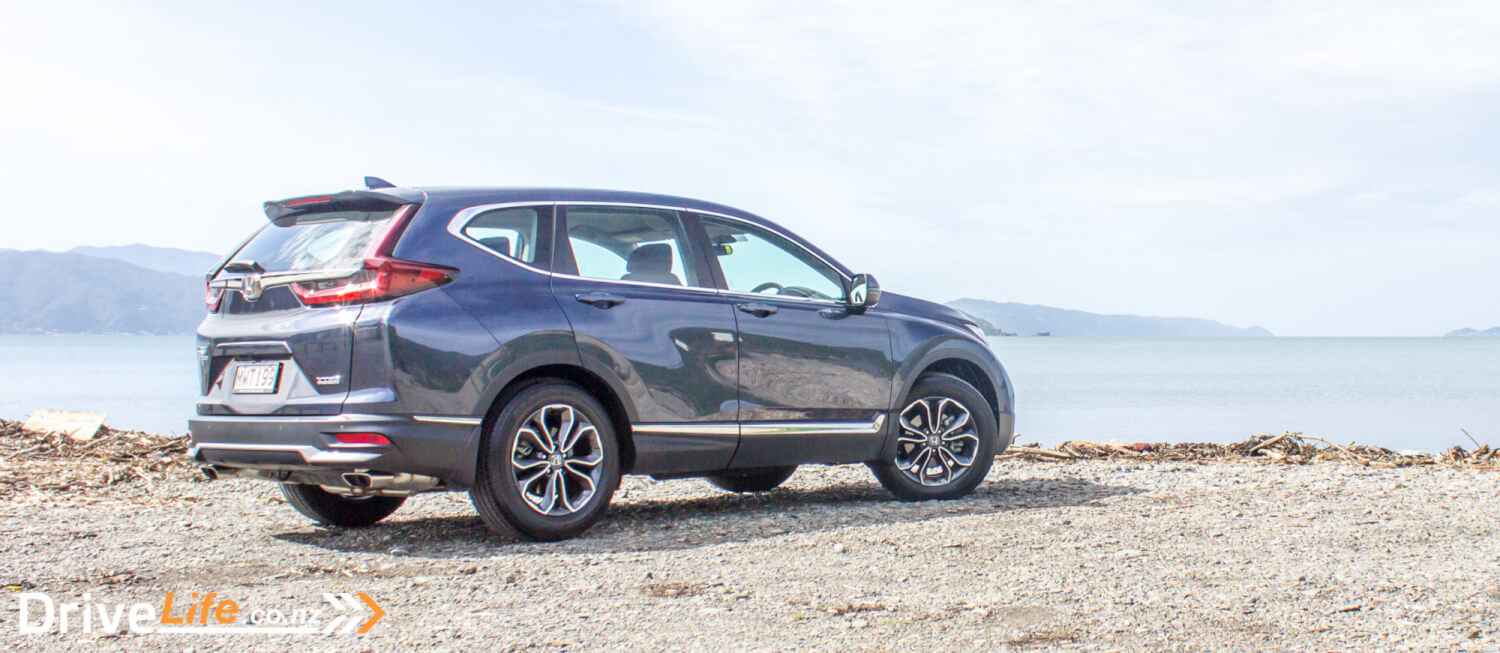
But all is not roses with the CR-V’s adaptive cruise. Incredibly, it doesn’t slow the car down a hill. It will if there’s a car in front of you, but if there’s not then the car will simply go faster and faster. I’ve only had two other cars that do this, and I remember them well as it’s such a rare thing to not have working in a car. The two others are the Nissan Pathfinder and the latest Toyota RAV4. I’ve no idea what the thinking is around this failing, but I can see CR-V owners trying to explain to a traffic cop that they couldn’t be speeding as they have their cruise control set to 100km/h. Imagine this on the Bombay Hill, you could be doing 140km/h very quickly.
Ride quality is one of the car’s highlights; it absorbs most bumps very nicely, never jarring the passengers, even on those short-sharp potholes that seem to be everywhere in Wellington, and motorway travel is a blissful experience. The Sport Premium has a panoramic sunroof with an electric blind, and a pop-up wind deflector. With it open on the motorway, there’s not much buffeting, but there is some wind noise from the wind deflector, but the same can be said for other cars with the same setup. It’s a huge sunroof, and lets a huge amount of natural light into the cabin.
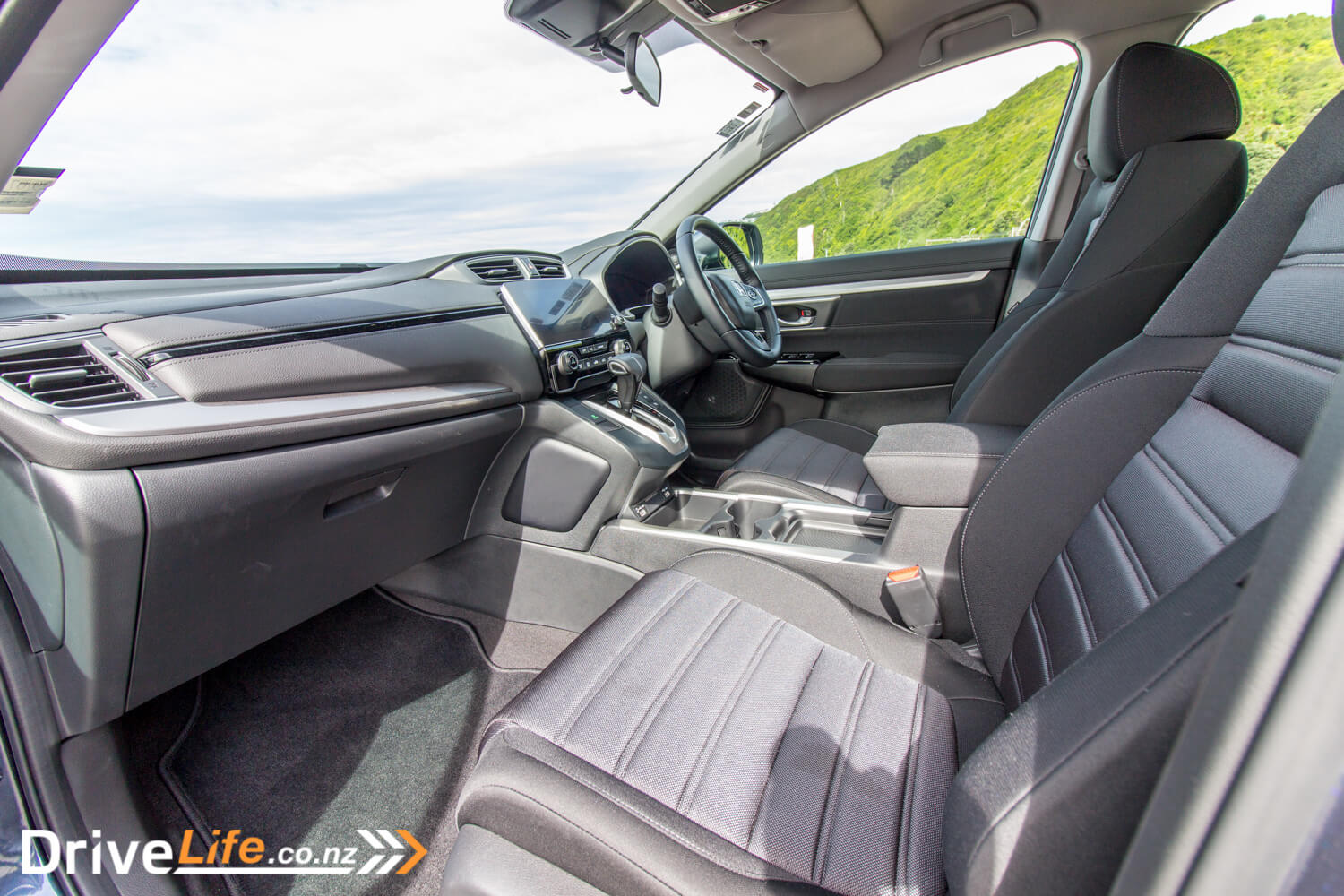
Honda’s infotainment has come in for some flack over the years, for looking a bit antiquated, and also being laggy. Both our test CR-Vs had the older-looking buttons and functions, but I did find one of the menus allowed me to change it to a much more modern look. This changed the look and feel of the infotainment system instantly, but I’m afraid the lag is still there. I sometimes flicked between screens, then thought it hadn’t worked and flicked again, but it was just slow. Hopefully this lag gets resolved at some point. On the plus side you have options to configure lots of things, and also there’s a good ‘ole volume on/off knob right there on the front, as it should be.

The dashboard on the base model is a bit of a mixed bag; it’s a little strange as there’s a centre panel which has a bar-type rev counter going across the panel, then a digital speedo below that. All around the speedo and below that is a multitude of other letters and numbers, and it’s all a bit too busy and confusing. Not only that, but the look of it all is a strange mix of modern and retro at the same time. To the left of this centre panel is a huge area for the temperature gauge, and the on the right the same but for fuel. The gauges themselves are quite small, and again they too look retro and yet modern, for me though, Honda hasn’t pulled it off. It took me a long time to get used to the gauges and how they read, and I longed for some normal, simple gauges with needles. I thought that maybe the Sport Premium might have some active dash or at least a different dash, but it’s exactly the same.
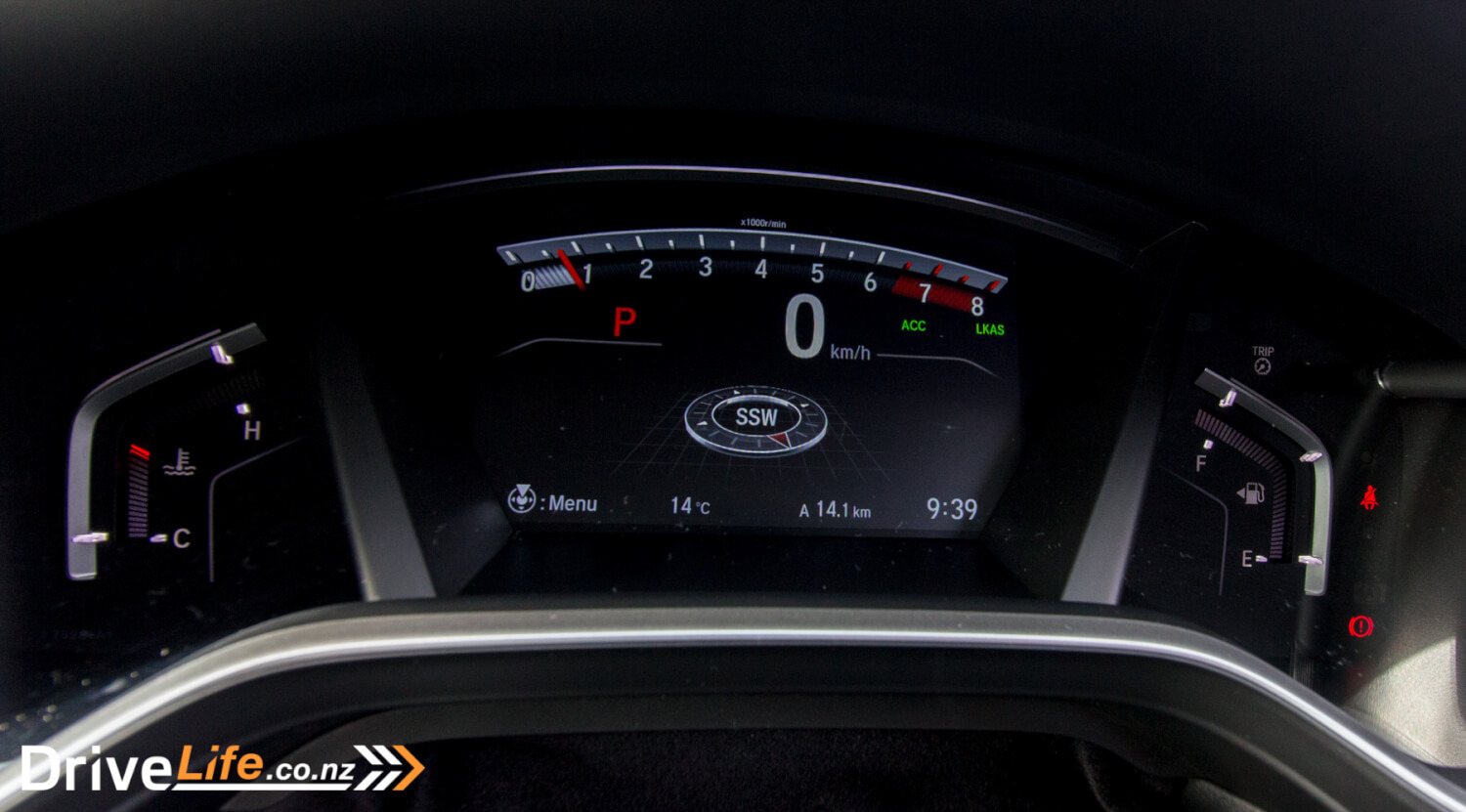
You would have noticed already I’ve mentioned that even the base spec model has SatNav – a surprisingly excellent move by Honda to standardise this. I hate to be a naysayer, but there’s a ‘but’ here. We were driving to Kapiti and using SatNav to test it out, as you do. For some reason, along SH1 SatNav told us to take a turn to go on to Transmission Gully. As much as I would have loved to have done this, that road isn’t open until next year. As we kept on SH1, the SatNav kept trying to redirect us to get on to Transmission Gully. Yes, the temptation was there to give it a go – “but officer, that’s what the SatNav told me to do” but common sense (i.e. my wife) stopped me from taking the turn – but I wanted to, so badly. It also did this on the return trip and told us to turn left at McKay’s Crossing to get on to the Gully road. We didn’t.
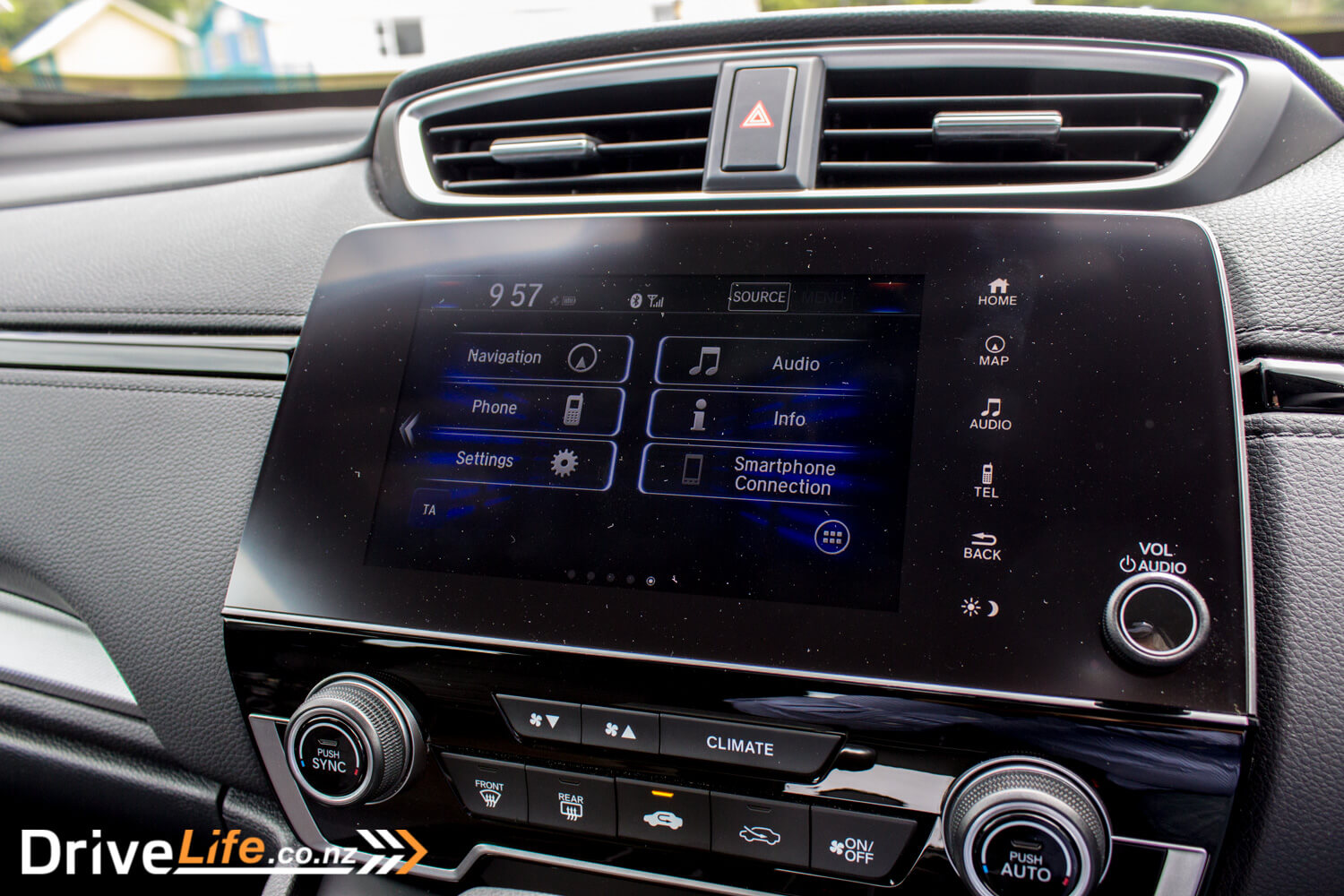
SatNav itself is a doddle to use, and if you select the SatNav option for the driver’s information display (DID), you’ll get some basic directions there along with a distance countdown as you get closer to a turn. A bit of shame that neither the central display nor the DID has the current speed limit shown. There’s no traffic sign recognition at all, so if the current speed limit where you are driving changes (e.g. roadworks) the central display is not going to update at all.
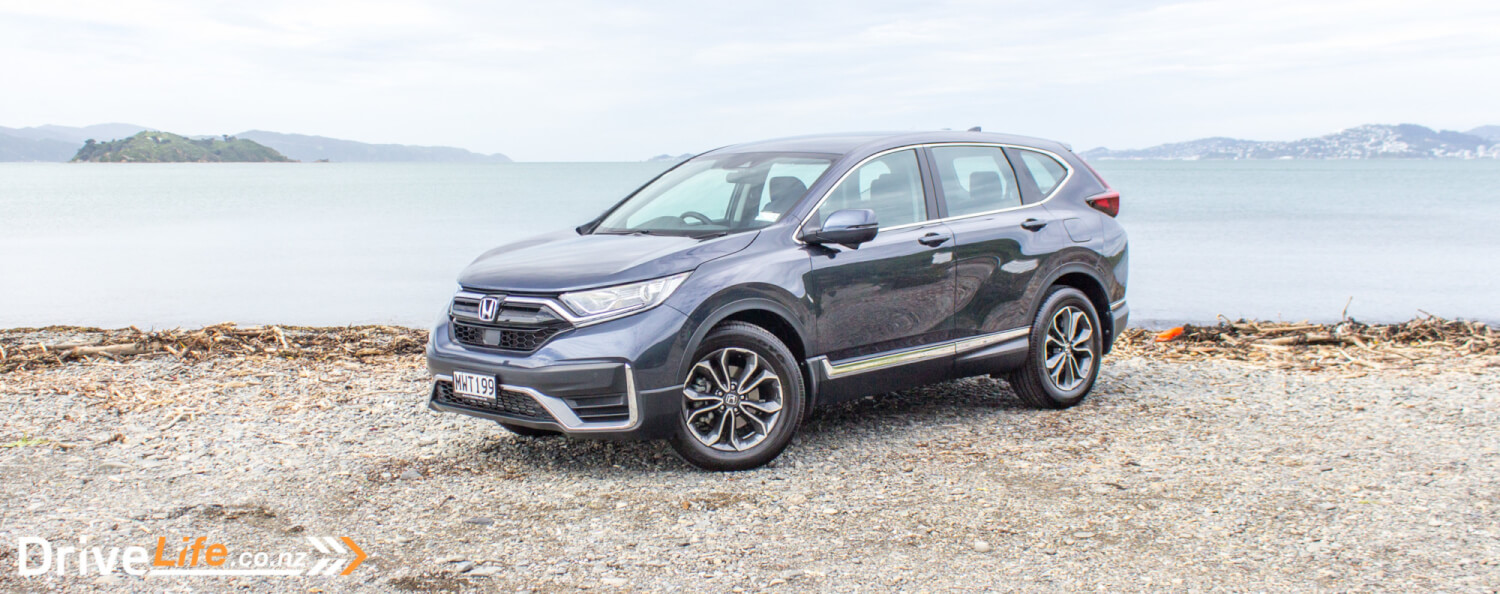
On the motorway, visibility is very good, except of course for that chunky C pillar. Helping you see the blind spots on the left of the car is one of those specific to Honda features that we’ve struck before is the Lane Watch Camera – and it’s still excellent. Great to see Honda haven’t played with this, and I’m surprised more manufacturers don’t do this as well. Lane Watch uses the camera on the left-hand mirror to show any blind spots on that side of the car, when you turn the indicator on. It’s a fantastic safety feature, and you can also turn it on manually by pushing in the button at the end of the indicator stalk. If it bugs you, you can switch it off in the menus so it won’t go on automatically. Does the base model include Lane Watch? Yes, it does. Well done, Honda. Note there is no blind spot monitoring, so while you have the Lane Watch Camera checking the left side of the car for you, there’s nothing to help you on the right-hand side, so you are going to have to remember to do a head check for your blind spot.

Audio quality is a bit of a highlight in either model, especially with the crisp higher-frequency notes coming out of the tweeters mounted high in the doors. There’s no CD player like some other current Honda models, but Bluetooth pairs easily.
The seats in the base model are quite comfy – I could see a long trip with these not being a problem. The leather seats in the Premium feel a lot firmer than the base, but still good overall. I did find the top-spec had more lateral support than the base spec, which tended to have front seat passengers rolling about a little. On the plus side, it was great to see sliding sun visors. I realise these are more expensive than ones that don’t slide, but they can’t be beat from a safety point of view.
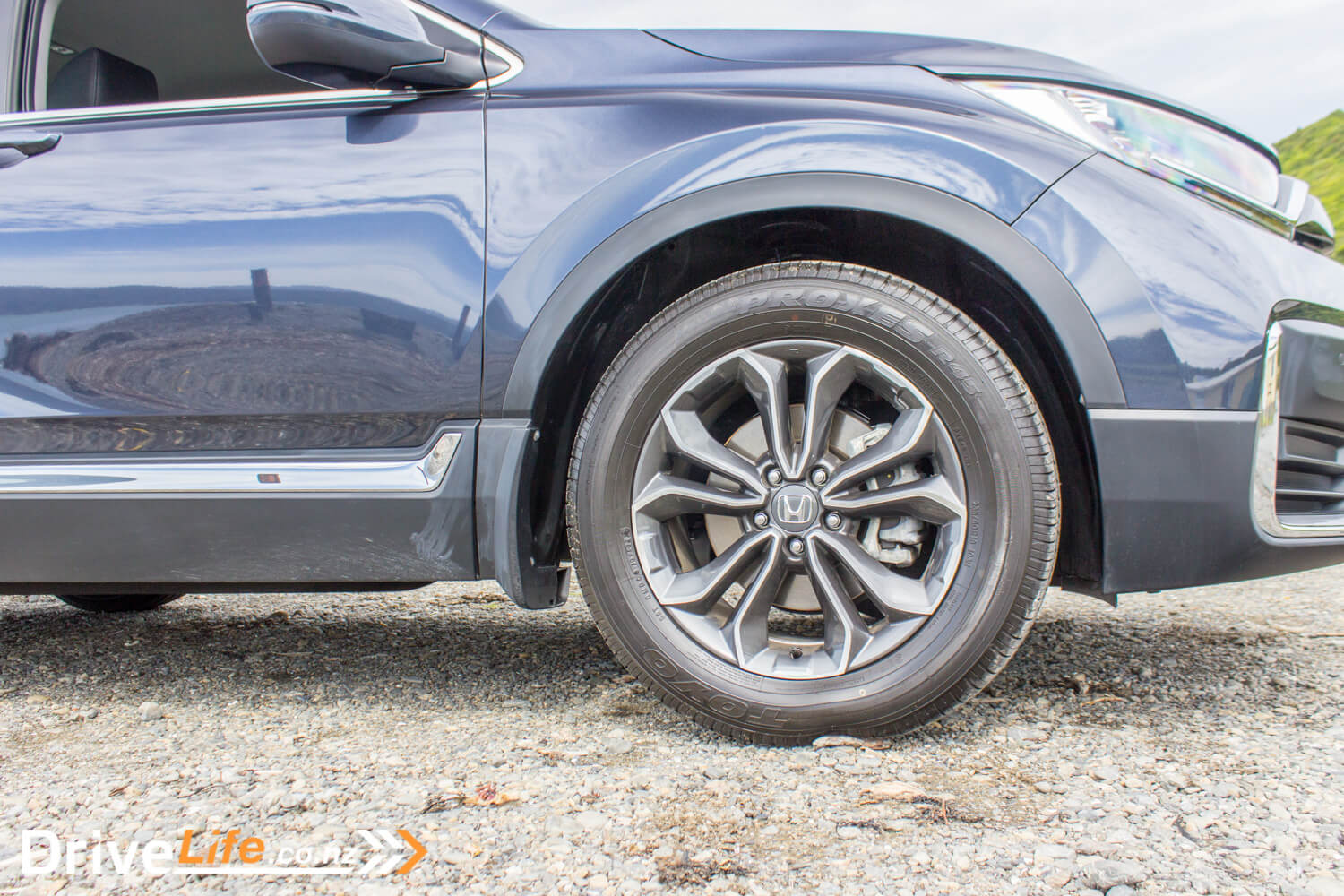
Handling on the CR-V is pretty good overall. It will roll if you push it and eventually go to understeer, but it feels pretty safe on the whole. It’s no CX-5 but will do just fine on the twisty bits. I couldn’t actually feel much different in this respect between the FWD and AWD models. There’s no doubt the AWD model has better grip, some of this may be down to the change in tyres, from Toyo Proxes R45s on the FWD to Michelin Latitude Sport 3 tyres on the AWD version.
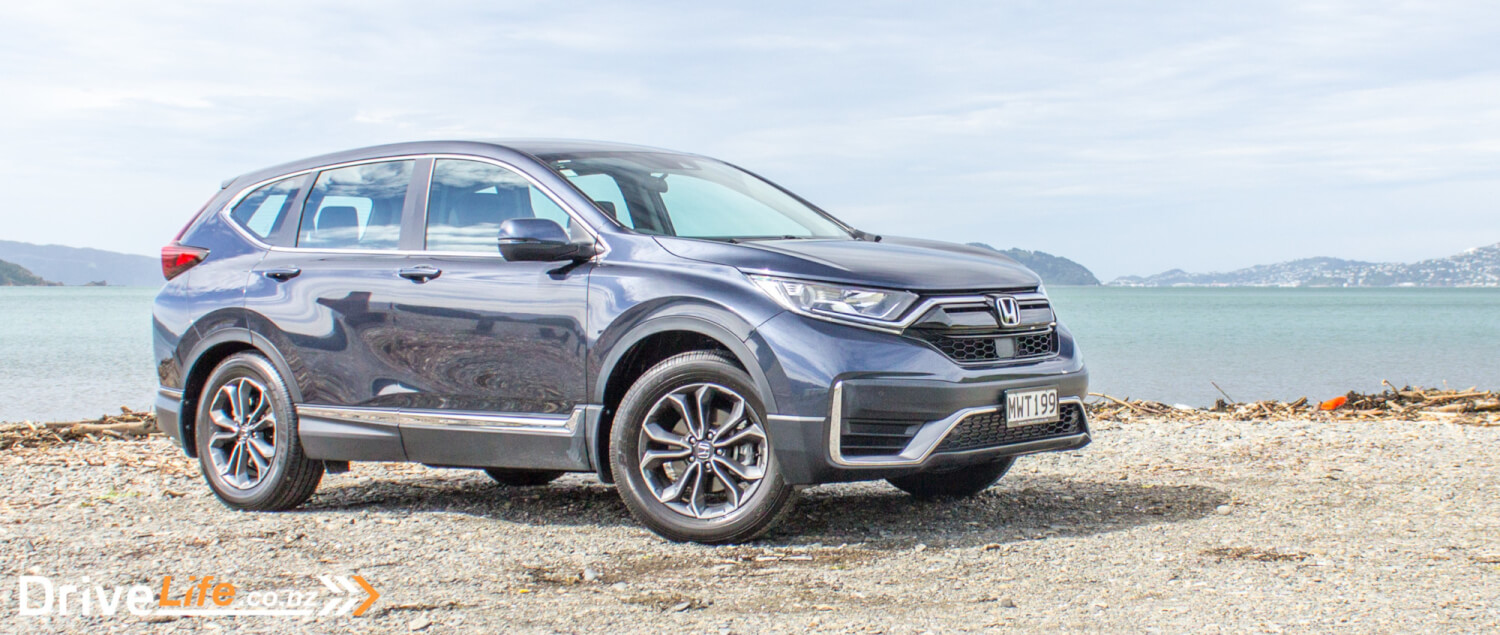
What’s The Competition For the 2020 Honda CR-V Touring?
To say the CR-V has some competition is a fair statement.
| Brand/Model | Engine | Power/Torque kW/Nm | Seats | Cargo capacity, litres | Tow Rating | Fuel L/100km | Price |
| Hyundai Tucson Limited AWD | 2.0-litre, 4-cylinder turbo | 130/265 | 5 | 488 | 750/1600 | 7.7 | $59,990 |
| Renault Koleos Sport AWD | 2.5-litre, 4-cylinder | 126/226 | 5 | 458 | 750/2000 | 8.3 | $57,990 |
| Mazda CX-5 Limited AWD | 2.5-litre, 4-cylinder | 140/252 | 5 | 455 | 750/2000 | 7.4 | $55,995 |
| Skoda Karoq TSI Sportline AWD | 2.0-litre, 4-cylinder turbo | 110/250 | 5 | 521 | NA/1500 | 6.3 | $55,990 |
| Ford Escape ST-Line AWD | 2.0-litre, 4-cylinder turbo | 183/387 | 5 | 406 | 750/1500 | 8.6 | $55,990 |
| Peugeot 3008 GT Line FWD | 1.6-litre, 4-cylinder turbo | 121/240 | 5 | 591 | NA | 7.3 | $52,990 |
| Kia Sportage GT Line AWD | 2.4-litre, 4-cylinder | 135/237 | 5 | 466 | 750/1500 | 8.5 | $51,990 |
| Honda CR-V Sport Premium AWD | 1.5-litre, 4-cylinder turbo | 140/240 | 5 | 522 | NA | 7.4 | $51,790 |
| Toyota RAV4 Adventure AWD | 2.5-litre, 4-cylinder | 152/243 | 5 | 542 | 750/1500 | 6.8 | $50,490 |
| Nissan X-Trail ST-L AWD | 2.5-litre, 4-cylinder | 126/226 | 5 | 565 | NA | 8.3 | $49,990 |
| Subaru Forester Premium AWD | 2.5-litre, 4-cylinder | 136/239 | 5 | 498 | 1500 | 7.4 | $49,490 |
| Mitsubishi Eclipse Cross VRX AWD | 1.5-litre, 4-cylinder turbo | 112/254 | 5 | 374 | 750/2000 | 7.7 | $47,590 |
What’s The Pros and Cons For The 2020 Honda CR-V Touring?
| Pros | Cons |
| Specs for base model Rear legroom Smooth drivetrain Lane Watch camera Ride quality Full-size spare Safety features Low boot loading height Good audio quality | Laggy infotainment system Cruise control functionality Dashboard design SatNav directions No blind-spot monitoring |
| Vehicle Type | 5-door medium-large SUV |
| Starting Price | $51,790 |
| Price as Tested | $51,790 |
| Engine | 1.5-litre, 4-cylinder turbo-petrol |
| Power, Torque kW/Nm | 140@5,500rpm 240@2,000-5,000rpm |
| Transmission | EarthDreams Automatic Continuously Variable Transmission CVT G-Design Shift |
| Spare Wheel | Full-size alloy |
| Kerb Weight, Kg | 1,636 |
| Length x Width x Height, mm | 4635x1855x1689 |
| Cargo Capacity, litres | 522/1658 |
| Fuel capacity, litres | 57 |
| Fuel Efficiency | Advertised Spec – combined – 7.4L/100km Real World Test – combined – 7.7L/100km Low Usage: 0-6 / Medium Usage 6-12 / High Usage 12+ |
| Towing Capacity Kg, unbraked/braked | NA/1,500 |
| Turning circle, metres | NA Small: 6-10m / Medium 10-12m / Large 12m+ |
| Warranty | 5 Years unlimited kilometre warranty 5 Years Roadside Assist |
| ANCAP Safety Ratings | 5 Star |


